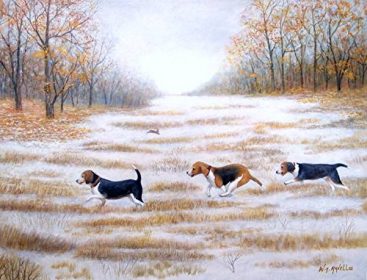
In Beagle field trials, dogs work in pairs called “braces,” and together, they work slowly and methodically to track cottontail rabbits. Small pack options (packs of seven) may track wild hare or rabbits, but large packs (up to twenty-five dogs) work the scent of hares, only. The Beagles are run according to both their size and sex (the dogs may be under 13 inches and over 13 inches, but not over 15 inches), and size does matter. As an aside, snowshoe hares are more popular in trials because of the size of their hind feet and their ability to run father, longer and straighter. Faster Beagles work in larger packs, sometimes with as many as thirty or forty dogs, but whatever the category (in addition to Brace, Small Pack, and Large Pack options, there are Gundog Brace field trials (in which pairs of beagles are turned loose to find their own rabbit), as well as Hunt Tests Two Couple Packs (in which Beagles are run in packs of four hounds set loose to find their own rabbit). Dogs are evaluated on how well they search for game, precision and speed.
It’s not easy to be a field trial judge because no small amount of effort goes into running after thirty or forty baying Beagles for 8 hours. Judges do it because of their dedication to the sport. Trials are a measure of the mettle of a hunting dog. At the end of the day, both literally and figuratively, the judges responsibility is to find the best Beagle among those entered with an eye to helping breeders produce the next generation of dogs that can do their job.
Image: “Three Beagles And A Bunny” by William Ravell III is available as a print here
